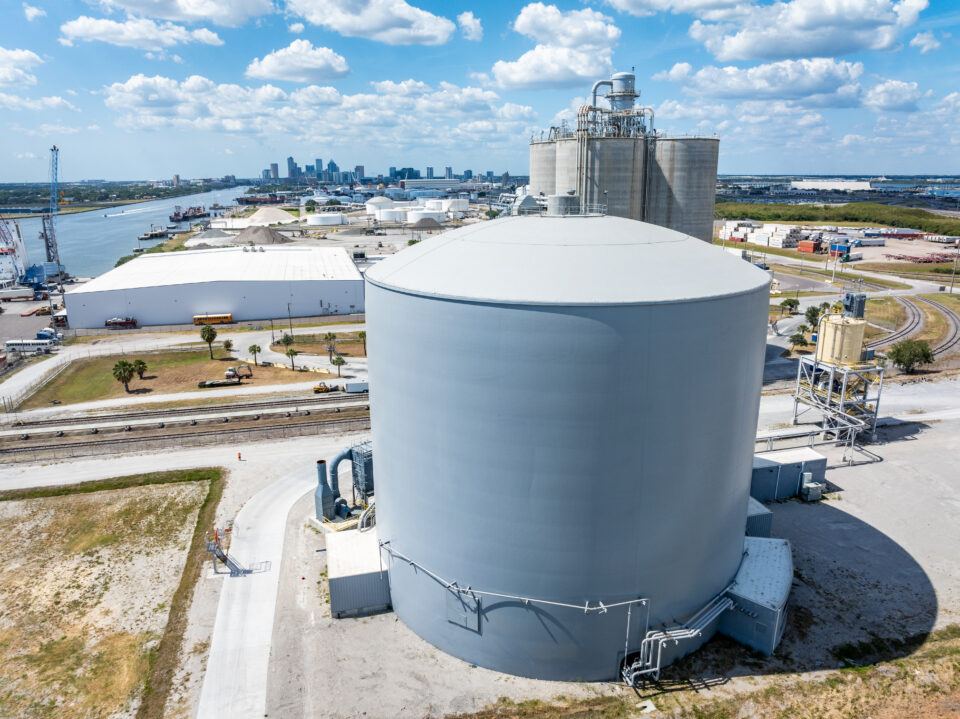Titan America is in the middle of its first year operating with a dome model so nice, they decided to build it twice.
Titan contracted with Dome Technology to complete the construction of identical DomeSilos in different East-coast locations, one in Florida and the other in Virginia.

Titan America: Tampa, Florida, USA
In the final quarter of 2023, Dome Technology completed a high-capacity DomeSilo for Titan America in Tampa, Florida. The DomeSilo is 142 feet in diameter and 141 feet tall.
The company had multiple priorities for the Tampa location. First, Titan wanted to maximize storage capacity despite the port’s height restriction. In response, Dome Technology fitted the DomeSilo with a low-profile domed roof that might not look like the typical dome but delivers robust strength. This allowed the structure’s vertical walls to reach as high as possible and provide the greatest possible cement storage.
“Our challenge before the dome was a full vessel of one product maxed out our capacity,” said Tampa plant manager Eric Poitras. “The dome now allows us the benefit of discharging two vessels back-to-back with different products without maxing out our storage.”
Second, the DomeSilo needed a robust dust-collection system. But it wasn’t possible to select a typical apex dust collector and still meet the capacity goals and height restriction. So Titan proposed a new idea: venting attached to the side of the dome and down to a dust collector at ground level. EDG Inc. prepared the new design that not only eliminates the need for a large apex platform, but also makes servicing and maintaining the dust collector easier. If needed in the future, this model will allow for ease in changing the dust collector.
Another priority was maximizing the portside property. The site’s soil conditions required a deep foundation to minimize settlement, and an auger-cast piling system with pile cap provided structural security from the ground up. Because of limited space, Dome Technology designed buildings for the Fuller-Kinyon (FK) Screw Pump and FLSmidth Cement Ful-Floor aeration blowers that curve around the DomeSilo exterior rather than standing separate.
Double-sided discharge points at the base of the DomeSilo combined with an FLSmidth Cement Ful-Floor pneumatic reclaim system ensure reclaiming isn’t interrupted if one transport system is temporarily out of order. FK pumps convey product from the DomeSilo to truck loadout silos.
Dome Technology’s scope of work included designing and installing the deep-foundations system, pile cap, dome tunnel, backfill, installation of the FLS aerated reclaim system, and ladder-tower and bridge fabrication, as well as the equipment buildings adjacent to the DomeSilo.
With construction complete, Titan American expects the DomeSilo will improve distribution and product flexibility into the future.
“The dome allows Titan to expand its customer base into West Central Florida by increasing the amount of cement we have available in that market. It also allows Titan the flexibility to bring multiple products into the marketplace,” Poitras said.

Titan America: Chesapeake, Virginia, USA
Dome Technology built another high-capacity DomeSilo for Titan in Chesapeake, Virginia, an identical structure to one built for the company in Tampa during the same time.
Because the Chesapeake site had a similar height restriction to the Tampa site, Titan chose a DomeSilo model that “is not a complete sphere but rather a cylinder with a dome roof,” Titan corporate director of projects Nasos Economou said. Although most of the height comes from vertical stem walls, the structure still benefits from the robust strength and monolithic integrity that comes standard with a DomeSilo.
One of Titan’s priorities was taking full advantage of the portside property. Like in Tampa, Chesapeake’s soil conditions required a deep foundation, and an auger-cast piling system with pile cap was chosen to minimize settlement. The facility also features curved buildings for the FK pump and blowers.
Loading and conveyance models are the same as the Tampa site. In Chesapeake, Dome Technology’s scope of work also included the dome tunnel, backfill, installation of the Ful-Floor reclaim system, and ladder-tower and bridge fabrication and installation.
According to Economou, Titan was able to achieve lower capital requirements by selecting a DomeSilo with its conveyance and reclaim systems. “The dome appears to be the most cost-effective solution for a single product,” he said.
The cement project portfolio
Two major advantages with the design-build model like Dome Technology offers are overall project costs are reduced and schedules are met because each phase of the project is built into the plan. These often yield cost savings and a smoother construction experience. These also contribute to the increasing number of repeat customers year on year.
Besides costing less to build and operate, domes are cost efficient. They are built with locally available concrete and reinforcing steel, and local crews are often hired for assisting in construction, a benefit for city economies as it provides jobs and pumps money back into the marketplace. Also, a dome’s double curvature requires fewer construction materials with significantly less waste, and a dome can be built quickly; one the outer weatherproof membrane is in place, construction moves inside and continues regardless of the weather.
If Dome Technology’s current project list is any indication, there’s no slowdown in sight for the cement industry. In 2023 the team either completed or started on 15 total construction projects, domestic and international, in a wide variety of industries, and cement was most dominant with eight projects. With sophistication on the increase, customers can secure the facility they want, and the process is made easier by selecting a construction company like Dome Technology that can oversee the project from start to finish.
Editor’s note: The preceding is an excerpt from an article published in the BMHR 2024 issue of World Cement.